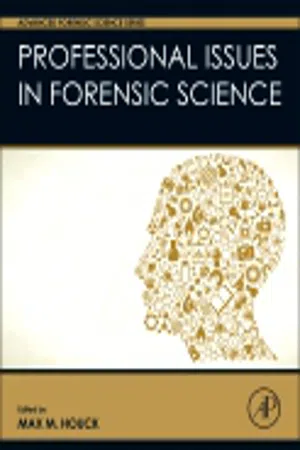
- 390 pages
- English
- ePUB (mobile friendly)
- Available on iOS & Android
Professional Issues in Forensic Science
About this book
Professional Issues in Forensic Science will introduce students to various topics they will encounter within the field of Forensic Science. Legal implications within the field will focus on expert witness testimony and procedural rules defined by both legislative statute and court decisions. These decisions affect the collection, analysis, and court admissibility of scientific evidence, such as the Frye and Daubert standards and the Federal Rules of Evidence. Existing and pending Forensic Science legislation will be covered, including laws governing state and national DNA databases. Ethical concerns stemming from the day-to-day balancing of competing priorities encountered by the forensic student will be discussed. Such competing priorities may cause conflicts between good scientific practice and the need to expedite work, meet legal requirements, and satisfy client's wishes. The role of individual morality in Forensic Science and competing ethical standards between state and defense experts will be addressed. Examinations of ethical guidelines issued by various professional forensic organizations will be conducted. Students will be presented with examples of ethical dilemmas for comment and resolution. The management of crime laboratories will provide discussion on quality assurance/quality control practices and the standards required by the accreditation of laboratories and those proposed by Scientific Working Groups in Forensic Science. The national Academy of Sciences report on Strengthening Forensic Science will be examined to determine the impact of the field.Professional Issues in Forensic Science is a core topic taught in forensic science programs. This volume will be an essential advanced text for academics and an excellent reference for the newly practicing forensic scientist. It will also fit strategically and cluster well with our other forensic science titles addressing professional issues.- Introduces readers to various topics they will encounter within the field of Forensic Science- Covers legal issues, accreditation and certification, proper analysis, education and training, and management issues- Includes a section on professional organizations and groups, both in the U.S. and Internationally- Incorporates effective pedagogy, key terms, review questions, discussion question and additional reading suggestions
Frequently asked questions
- Essential is ideal for learners and professionals who enjoy exploring a wide range of subjects. Access the Essential Library with 800,000+ trusted titles and best-sellers across business, personal growth, and the humanities. Includes unlimited reading time and Standard Read Aloud voice.
- Complete: Perfect for advanced learners and researchers needing full, unrestricted access. Unlock 1.4M+ books across hundreds of subjects, including academic and specialized titles. The Complete Plan also includes advanced features like Premium Read Aloud and Research Assistant.
Please note we cannot support devices running on iOS 13 and Android 7 or earlier. Learn more about using the app.
Information
Introduction
History of Forensic Sciences
Abstract
Keywords
Criminalistics; DNA; Forensic science; History; Information technology; Interpretation; PioneersGlossary
Table of contents
- Cover image
- Title page
- Table of Contents
- Copyright
- Editor: Biography
- List of Contributors
- Foreword
- Overview
- Section 1. Introduction
- Section 2. Analysis
- Section 3. Management Issues
- Section 4. Accreditation and Certification
- Section 5. Education and Training
- Section 6. Legal Issues
- Section 7. Professional Organizations and Groups
- Index